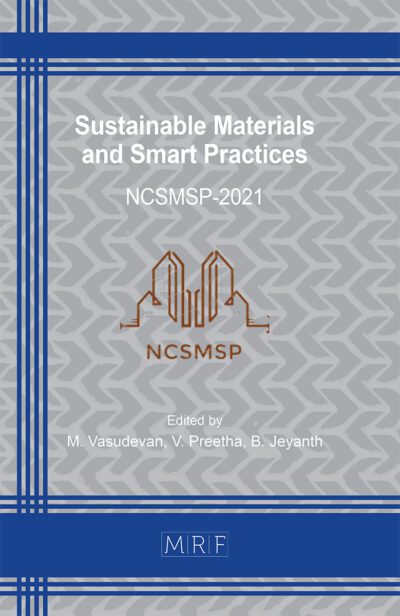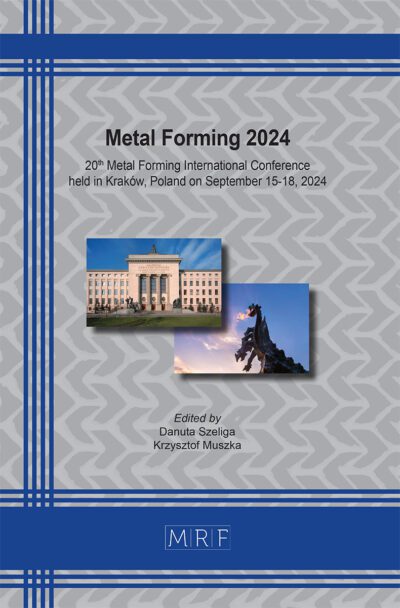Influence of forming temperature on damage and product performance in hot stamping of steel
Philipp Lennemann, A. Erman Tekkaya, Yannis P. Korkolis
Abstract. The influence of the forming temperature on damage evolution and product performance is investigated. A hot stamping setup for hat profiles is utilized to form parts at different temperatures between 600 and 900 °C. Geometrical properties such as thickness and bending radius as well as hardness show no significant difference between the parts formed at different temperatures. In contrast, void area fractions measured by scanning electron microscopy show that high temperatures lead to lower damage evolution. The product performance is assessed by a quasi-static setup to bend the parts even further at room temperature to fracture. The bending tests show that a high forming temperature during hot stamping leads to higher fracture strains of the parts during service.
Keywords
Sheet, Hot Stamping, Damage
Published online 5/7/2025, 8 pages
Copyright © 2025 by the author(s)
Published under license by Materials Research Forum LLC., Millersville PA, USA
Citation: Philipp Lennemann, A. Erman Tekkaya, Yannis P. Korkolis, Influence of forming temperature on damage and product performance in hot stamping of steel, Materials Research Proceedings, Vol. 54, pp 1249-1256, 2025
DOI: https://doi.org/10.21741/9781644903599-136
The article was published as article 136 of the book Material Forming
![]() Content from this work may be used under the terms of the Creative Commons Attribution 3.0 license. Any further distribution of this work must maintain attribution to the author(s) and the title of the work, journal citation and DOI.
Content from this work may be used under the terms of the Creative Commons Attribution 3.0 license. Any further distribution of this work must maintain attribution to the author(s) and the title of the work, journal citation and DOI.
References
[1] H. Karbasian, A.E. Tekkaya, A review on hot stamping, Journal of Materials Processing Technology 210 (2010) 2103–2118. https://doi.org/10.1016/j.jmatprotec.2010.07.019
[2] M. Merklein, J. Lechler, Determination of material and process characteristics for hot stamping processes of quenchable ultra high strength steels with respect to a FE-based process design, SAE World Congress (2008).
[3] M.C. Somani, L.P. Karjalainen, M. Eriksson, M. Oldenburg, Dimensional Changes and Microstructural Evolution in a B-bearing Steel in the Simulated Forming and Quenching Process, ISIJ International 41 (2001) 361–367. https://doi.org/10.2355/isijinternational.41.361
[4] M. Naderi Hot stamping of ultra high strength steels, Doctoral Theses, RWTH Aachen, 2007.
[5] F. J. Lenze, S. Sikora, Herstellung von Karosseriebauteilen aus warmumgeformten höchstfesten Stahlwerkstoffen, Proceedings of 1. Erlanger Workshop (2006) 1-12.
[6] M. Merklein, J. Lechler, Investigation of the thermo-mechanical properties of hot stamping steels, Journal of Materials Processing Technology 177 (2006) 452–455. https://doi.org/10.1016/j.jmatprotec.2006.03.233
[7] W. He, B. Yang, X. Zhang, M. Li, S. Sun, B. Wang, Q. Ma, Investigation into the Hot-Forming Limit for 22MnB5 Hot-Forming Steel under a Stamping Process, Metals 14 (2024) 561. https://doi.org/10.3390/met14050561
[8] A.E. Tekkaya, P.-O. Bouchard, S. Bruschi, C.C. Tasan, Damage in metal forming, CIRP Annals 69 (2020) 600–623. https://doi.org/10.1016/j.cirp.2020.05.005
[9] R. Meya Schädigungskontrolliertes Blechbiegen mittels Druckspannungsüberlagerung, Doctoral Theses, TU Dortmund, 2020.
[10] G. Venturato, A. Ghiotti, S. Bruschi Stress-state dependent formability modelling in hot stamping, Production Engineering 14 (2020) 105–114. https://doi.org/10.1007/s11740-019-00941-z
[11] B. Tang, F. Wu, Q. Wang, J. Liu, N. Guo, H. Ge, Q. Wang, L. Peixing, Damage prediction of hot stamped boron steel 22MnB5 with a microscopic motivated ductile fracture criterion: Experiment and simulation, International Journal of Mechanical Sciences 169 (2020) 105302. https://doi.org/10.1016/j.ijmecsci.2019.105302
[12] M. Stennei, J. Grodotzki, A.E. Tekkaya, Material Properties of a Roll-Cladded Steel Composite Designed for Press Hardening With Rapid Heating, CHS² 2024 Proceedings (2024) 53-59
[13] P. Ludwik, Technologische Studie über Blechbiegung, Technische Blätter (1903) 133-159
[14] J. Lemaitre, J. Dufailly, Damage measurements, Engineering Fracture Mechanics 28 (1987) 643-661. https://doi.org/10.1016/0013-7944(87)90059-2














